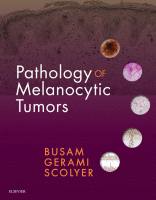Physical Address
304 North Cardinal St.
Dorchester Center, MA 02124

The uveal tract is the pigmented vascularized soft tissue coat of the eye. It consists of the iris, ciliary body, and choroid. Melanocytic lesions can occur throughout the uveal tract. These invclude nevi, and what may be their malignantly transofrmed…

Complexion-Associated Melanosis Complexion-associated melanosis is a benign conjunctival pigmentation that occurs more frequently in patients with darkly pigmented skin. Clinical Findings Complexion-associated melanosis, as implied in the name, tends to affect individuals with dark skin. Clinically it manifests as fine…

Pediatric melanoma is a rare entity, accounting for less than 1% of all melanoma cases. Most pediatric melanomas develop sporadically (de novo) without a known underlying condition or genetic predisposition. For example, alterations in the melanoma susceptibility gene CDKN2A, which…

The purpose of this chapter is to present unusual morphologic variants of primary cutaneous melanomas, which are not the subject of specific chapters elsewhere in the book. The main value of mentioning and describing these variants is for the practicing…

Melanoma may develop in association with a blue nevus (BN), in particular a cellular blue nevus (CBN), or closely simulate the appearance of a BN (BN-like melanoma). Such tumors have historically been referred to as malignant blue nevus . Malignant…

There is currently no consensus definition on what constitutes a “spitzoid” melanoma. The term is most often used in a practical sense referring to a diagnostic pitfall: a melanocytic neoplasm that at first glance simulates the appearance of a Spitz…

The term nevoid melanoma refers to melanomas, which closely resemble a melanocytic nevus under the microscope. It primarily refers to a diagnostic pitfall. In principle any type of nevus could be mistaken for melanoma, and the term “nevoid” melanomas could…

Desmoplastic melanoma (DM) is a rare variant of melanoma that is histopathologically characterized by the dispersion of invasive tumor cells in a collagen-rich stroma. The tumor cells are usually amelanotic and predominantly fusiform in appearance. DM can be confused with…

Any melanoma, including the common variants superficial spreading, lentigo maligna, and acral lentiginous melanoma, may form an invasive tumor nodule. However, the presence of a prominent nodule does not equate a nodular melanoma (NM) subtype ( Fig. 15.1 ). According…

General Comments Melanocytic lesions of acral skin are at particular risk of being misdiagnosed for a variety of reasons. On the one hand, acral melanoma (AM) may have very subtle histologic features, particularly in the early in situ stage and…